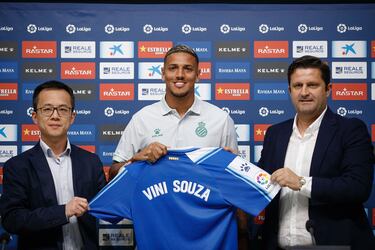How many non-EU community players can there be in each LaLiga club; how many does each one have?
Every LaLiga club is allowed a maximum number of non-EU Community players in their squad. The concept has a long history.

The 20 clubs in LaLiga have practically closed their squads for the new season and those that haven’t have just two days to make any last minute reinforcements. In general, the majority of players registered to play in LaLiga are either Spanish-born, or from countries belonging to the European Union.
However, there is also an allocation for players who were born in countries in other continents, who hold non-EU passports. Here, we take a look at how many non-EU nationals are allowed at each LaLiga club and how many each one currently has on their books.
What does it mean for a footballer to be from outside the EU?
The answer to this question is simple. If a player is considered non-EU, he was born in a country that does not belong to the European Union, and, therefore, his passport is not linked to any of the nations that form part of this community.
EU Community players are those who were born in countries which belong to the EU - or have managed to obtain dual nationality. These cases occur on occasions, when a footballer from another continent, in addition to being able to sign for a specific team, wants to change teams due to lack of opportunities, one clear example of that was Diego Costa, who was stripped of his Brazilian citizenship so that he could play for Spain.
How many non-EU players are allowed at each LaLiga club?
Currently, each club can register a maximum of three players who do not possess a European Union passport. However, this was not always the case. Up until 1974, no foreign players could play in the Spanish league, unless they had dual nationality or it was proven that the players had Spanish ancestors.
As La Cadena SER recently pointed out, Johan Cruyff’s arrival at Barcelona changed everything regarding the quota of foreign players at Spanish clubs. From that moment on, two places allocated for foreign players were allowed in each top flight club. In 1990, the quota rose to three, and in 1995, the Bosman Ruling heralded a revolution for non-EU citizens.
The Bosman Ruling effectively abolished nationality quotas for clubs within the EU-European Economic Area. Also, with the signing of the Cotonou Agreement in 2000, the number of players that were able to comply was expanded significantly. What is the agreement about? It means that players from African, Caribbean and Pacific Group of States can apply to be naturalized in their host country.
How many non-EU Community players does each LaLiga club have in their squad?
Almería
- Kaiky
- Sadiq (Signed under the Cotonou Agreement)

Athletic Club
It does not have non-EU Community players. His philosophy, consisting of reinforcing his team with players from his own academy or from the area, prevents him from doing so.
Atlético Madrid
- Matheus Cunha
- Felipe Augusto
- Nahuel Molina
- Reinildo Mandava (Signed under the Cotonou Agreement)

Barcelona
- Ronald Araújo
- Franck Kessié (Signed under the Cotonou Agreement)

Betis
- Paul Akouokou (Signed under the Cotonou Agreement)
- Luiz Henrique

Cádiz
- Santiago Arzamendia
- Tomás Alarcón
- Awer Mabil (Signed under the Cotonou Agreement)

Celta Vigo
- Joseph Aidoo (Signed under the Cotonou Agreement)

Elche
- Enzo Roco
- Helibelton Palacios

Espanyol
- Vinícius Souza
- Matías Vargas

Getafe
- Gastón Álvarez
- Mauro Arambarri

Girona
Related stories
Does not have any non-EU Community players
Mallorca
- Brian Cufré
- Kang-in Lee
- Amath Ndiaye (Signed under the Cotonou Agreement)

Osasuna
It does not have non-EU players, the foreign players it has on the books have dual nationality or belong to the EU.
Rayo Vallecano
- Radamel Falcao
- Pathé Ciss (Signed under the Cotonou Agreement)

Real Madrid
- Vinicius Junior
- Rodrygo Goes
- Eder Militao

Real Sociedad
- Takefusa Kubo

Sevilla
- Marcao
- Marcos Acuña
- Bono (Signed under the Cotonou Agreement)
- Youssef En-Nesyri (Signed under the Cotonou Agreement)

Valencia
- Samuel Lino
- Maxi Gómez
- Marcos André
- Giorgi Mamardashvili (Signed under the Cotonou Agreement)

Valladolid
- Lucas Olaza
- Gonzalo Plata
- Stiven Plaza
- Jawad El Yamiq (Signed under the Cotonou Agreement)

Villarreal
- Samu Chukwueze (Signed under the Cotonou Agreement)


